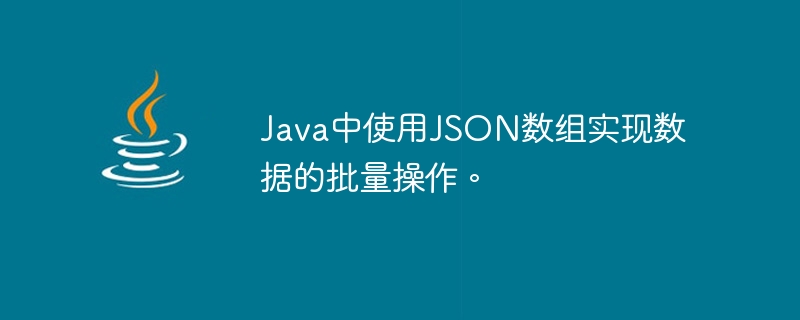Home >Java >javaTutorial >JSON arrays are used in Java to implement batch operations of data.
JSON arrays are used in Java to implement batch operations of data.
- 王林Original
- 2023-09-06 12:39:22802browse

Using JSON arrays in Java to implement batch operations of data
As the requirements for data processing become more and more complex, the traditional single data operation method can no longer meet our needs need. In order to improve the efficiency and flexibility of data processing, we can use JSON arrays to implement batch operations of data. This article will explain how to use JSON arrays for batch operations in Java, with code examples.
JSON (JavaScript Object Notation) is a lightweight data exchange format commonly used to transfer data between front and back ends. It can represent complex data structures and has good readability and easy parsing. In Java, we can use third-party libraries such as Jackson or Gson to manipulate JSON data.
First, we need to import the relevant dependencies of the JSON library. Taking the Jackson library as an example, you can add the following dependencies in the pom.xml file of the Maven project:
<dependency>
<groupId>com.fasterxml.jackson.core</groupId>
<artifactId>jackson-databind</artifactId>
<version>2.x.x</version>
</dependency>Next, we will use an example to illustrate how to use JSON arrays to implement batch operations of data. Suppose we have a student class Student, which contains the student's name and age attributes:
public class Student {
private String name;
private int age;
// 构造函数、Getter和Setter方法等省略
}Now, we have a JSON array containing the information of multiple students. We want to batch add these student objects to a student list for subsequent operations. The following is a code example to implement this function:
import com.fasterxml.jackson.databind.ObjectMapper;
import java.util.ArrayList;
import java.util.List;
public class BatchOperationExample {
public static void main(String[] args) {
try {
ObjectMapper mapper = new ObjectMapper();
// 模拟从外部获取的JSON数组数据
String json = "[{"name":"张三","age":18},{"name":"李四","age":20}]";
// 将JSON数组转换为Java对象数组
Student[] students = mapper.readValue(json, Student[].class);
// 创建学生列表
List<Student> studentList = new ArrayList<>();
// 将学生对象添加到学生列表中
for (Student student : students) {
studentList.add(student);
}
// 输出学生列表信息
for (Student student : studentList) {
System.out.println("姓名:" + student.getName() + ",年龄:" + student.getAge());
}
} catch (Exception e) {
e.printStackTrace();
}
}
}In the above code, we use the ObjectMapper class to convert the JSON array into an array of Java objects. Then, we create a list of students and add student objects to the list one by one. Finally, we loop through the list of students and output the name and age of each student.
Through this example, we can see how to use JSON arrays to implement batch operations of data. In addition to adding data in batches, we can also perform batch updates, deletions and other operations according to specific needs. Using JSON arrays can help us simplify the code, improve efficiency, and be more flexible and scalable.
To summarize, this article introduces how to use JSON arrays to implement batch operations of data in Java. We demonstrated with an example how to convert a JSON array to an array of Java objects and store the objects into a list. I hope readers can understand the application of JSON arrays in Java through this article and be able to use it flexibly in actual development.
The above is the detailed content of JSON arrays are used in Java to implement batch operations of data.. For more information, please follow other related articles on the PHP Chinese website!

